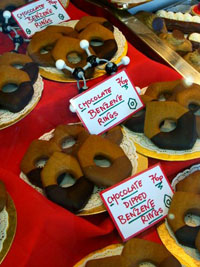From dough ring to benzene ring

What does the humble sugar doughnut have in common with a Nobel Prize and a pioneering discovery in chemistry?
The answer… the window of a well-known Fife bakers’ shop.
Known across Scotland for its mouth-watering displays of home-baked cakes and confectionery, the shop-front of Fisher and Donaldson in Church Street, St Andrews, has another, unlikely, claim to global fame…
As a consequence of groundbreaking research at the University of St Andrews over 80 years ago, it became the first place in the world to publicly present the chemical structure of the compound benzene.
In the 1920s, benzene was regarded as an extremely important substance, both for its many practical uses and because of its chemical structure and properties. Distinguished chemists had argued for decades about the best way to represent benzene in a chemical formula.
In 1925, Professor of Chemistry at St Andrews Robert Robinson and his research student James Armit published a seminal paper suggesting that benzene could best be represented by a ring diagram – a circle inside a hexagonal arrangement of carbon atoms. Robinson, later Sir Robert, went on to win the Nobel Prize and become one of the all-time greatest organic chemists. His co-author James Armit left a more modest legacy.
The son of a family of bakers who in 1925 owned the shop in Church Street, Armit took a glass knife and proudly engraved a picture of the new formula into the glass frontage of the shop.
It was to become the first ever public presentation of a benzene ring in this style, now used and accepted worldwide. The original glass is long gone, but Fishers and the School of Chemistry at St Andrews will remember the link to Armit and Robinson with a special display in the shop this week.
Professor Derek Woollins, Head of the School of Chemistry, said, “Armit and Robinson’s paper was a milestone in international chemical research. In the days before mass media, the internet and email, Armit’s decision to engrave the discovery into the glass window of his family shop is a wonderful reminder of the pride and excitement he must have felt at this breakthrough.
“We’re delighted to have teamed up with Fisher and Donaldson to uncover this little bit of hidden St Andrews history.”
Issued by the University of St Andrews
Contact: Niall Scott, tel 01334 462244, mobile 07711 223062, [email protected]
Category Community